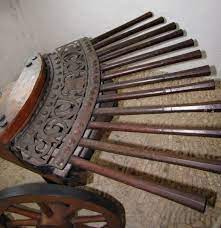Key Point: A Ribauldequin is a medieval multiple-barreled, early artillery weapon used for firing multiple small-caliber projectiles simultaneously.
In this article we will be taking a look at the Ribauldequin. It was a weird looking cannon used on the battlefield. And here we will be examining what made it so powerful and effective. And of course what downsides it had that ultimately lead to it being removed from battle.
Now … lets examine this piece of cannon history by starting at the beginning. What is the Ribauldequin?
Ribauldequin was a medieval multiple-barrel firearm used in warfare. It consisted of a large box-like frame equipped with several barrels, allowing it to fire a volley of projectiles simultaneously, inflicting heavy damage on enemy forces.
That was the short definition. Now, lets continue with its origin and we will move on from there.
Its Origins

The development of Ribauldequin stemmed from the need for increased firepower on the battlefield. The name “Ribauldequin” itself is believed to have derived from the French word “ribaud,” meaning scoundrel or rascal, alluding to its disruptive and chaotic nature when unleashed in combat.
The concept behind Ribauldequin was to create a compact and versatile artillery piece that could deliver a concentrated barrage of projectiles.
It was an innovation that sought to overcome the limitations of single-barreled cannons by incorporating multiple barrels into a single weapon system. The ingenuity behind this design allowed for the simultaneous firing of numerous small-caliber projectiles, multiplying the destructive potential on the battlefield.
The exact origins of Ribauldequin are not entirely clear, as multiple variations of the weapon were developed and used across different regions of Europe.
So, what were the physical characteristics of the Ribauledquin that made it stand out? Lets find out.
Physical Characteristics Of Ribauldequin
Ribauldequins were relatively compact and lightweight compared to other cannons of their time. They were constructed with multiple small-caliber barrels mounted on a wooden frame. These cannons often had between six to thirty barrels, arranged in rows or tiers. The barrels were made of iron or bronze, and the entire contraption was mounted on a pivoting stand.
Moving on from the physical characteristics of Ribauldequin, let’s now delve into the kind of caliber projectiles it fired.
Caliber Of Its Projectiles
Ribauldequins were designed to fire a barrage of small-caliber projectiles simultaneously. These projectiles, known as bolts or arrows, were typically smaller and lighter compared to traditional cannonballs. They were made of iron or sometimes wood, and their purpose was to create a widespread and devastating effect on enemy formations.
Let’s now explore any disadvantages of this weapon and how those contributed to its decline.
Disadvantages Of Ribauldequin And Its Decline
While Ribauldequins were formidable weapons, they had certain drawbacks that contributed to their eventual decline.
One notable disadvantage was their limited range and accuracy compared to other cannons. The spread of projectiles fired simultaneously resulted in diminished precision, making them less effective against fortified positions.
Also, the time-consuming reloading process and the complexity of aiming multiple barrels proved challenging, especially in rapidly changing battlefield scenarios. These factors, gradually led to the decline of Ribauldequin as advancements in artillery technology offered more reliable and efficient alternatives.
Now that we have discussed the disadvantages of Ribauldequin and its decline, let’s examine what kind of cannons came after it.
Successors To Ribauldequin
Following the decline of Ribauldequin, artillery development continued to progress. The subsequent cannons that emerged displayed advancements in design and functionality. One notable successor was the Culverin, which featured a longer and more refined barrel. Culverins offered increased range, enhanced accuracy, and improved projectile velocity compared to Ribauldequins.
These developments allowed for more effective artillery fire, both in siege warfare and open-field battles.
Another significant successor to Ribauldequin was the Basilisk. Basilisks were characterized by their even longer barrels, which further extended the range and improved accuracy. These cannons became renowned for their ability to deliver devastating blows to enemy fortifications, making them invaluable assets in siege warfare.
Let’s take a look at any modern-day depictions of this weird cannon. And let’s focus on a game I am sure you have heard about.
Ribauldequin In The Age Of Empires Games
In the famous Age of Empires II game, the Ribauldequin plays a part.
The Britons civilization known for their skilled archers, have the Ribauldequin added to their arsenal that allows them to pack an extra punch.
The Ribauldequin is a specialized siege weapon in the game. It resembles a large cart with multiple barrels mounted on top. These barrels are loaded with various projectiles, such as arrows or stones. And then fired at the enemy. In the game when you deploy your ribauldequins, you gain access to a devastating area-of-effect attack.
The Ribauldequin unleashes a volley of projectiles, that causes damage to nearby enemy units. This makes it an effective tool for weakening enemy defenses during sieges or large-scale battles. To use the ribauldequin effectively, players must position it strategically, taking into account the range and line of sight of the weapon.
So when you coordinate its attacks with other units can lead to devastating results, since the Ribauldequin’s barrage can decimate enemy forces in a concentrated area. The inclusion of the Ribauldequin in the Age of Empires games adds historical authenticity to the gameplay.
Allowing players to experience the power and impact of this medieval siege weapon. It provides an additional tactical option for players controlling the Briton’s civilization, enhancing their ability to break through enemy fortifications and gain a strategic advantage.
In Conclusion
Thank you for taking the time to read this article. I hope you learned a thing or two about this wonderful piece of cannon history. And I will see you at the next one.
Take care!
Sources: